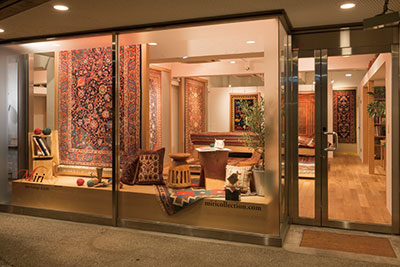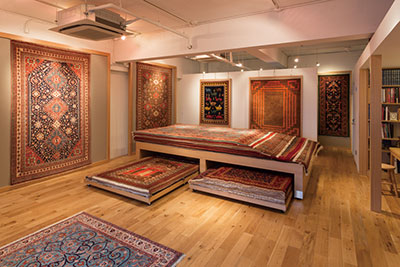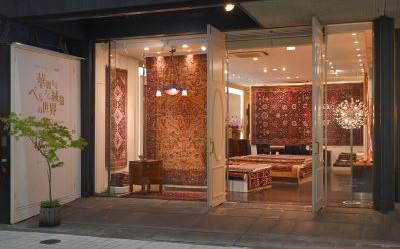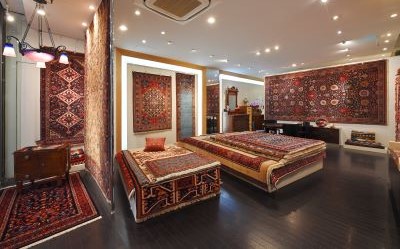- Home
- About
- Process
- Collection
- お問合せ
- Inquiry


千代田トレーディング株式会社
ミーリー工房日本総代理店
ミーリーコレクション
CHIYODA TRADING CO., LTD.
Japan exclusive distributor
Miri Iranian knots
108-0071 東京都港区白金台5-3-7 くりはらビル101 [Google Map]
#101 Kuriharabiru 5-3-7 Shirokanedai,Minato-ku, Tokyo-to 108-0071 [Google Map]
Telephone 03 3440 9391
Facsimile 03 3440 9392
営業時間:10:30~18:00 火曜定休日
Business hours: 10:30-18:00 Closed on Tuesdays



ミーリーコレクション Kumamoto
Miri Iranian knots Kumamoto
860-0845 熊本県熊本市中央区上通町1-15 上通パビリオン内 [Google Map]
1-15 Kamitoricho Chuo-ku,Kumamoto-shi, Kumamoto-ken 860-0845 [Google Map]
Telephone 096 325 8805
Facsimile 096 325 8812
営業時間:11:00~19:00
Business hours: 11:00-19:00
Miri Iranian Knots
イランの起伏に富んだ地形と厳しい自然環境が、染料となる植物の鮮やかな色彩を生み出します。ザグロスの山々で育つ羊たちは、春の毛刈りまで十分な油分と弾力性に富む羊毛を蓄えます。ミーリー工房が制作する絨毯になくてはならない自然の恵みです。
山羊や鳥、木々、可憐な花々。ミーリーの作品には、長い歴史をもち、いくつもの物語や願いをこめた図柄が織りこまれ、躍動しています。
デザイナーたちは神話や自然の造形に思いを馳せながら、心をこめて下絵を描きます。
昔ながらに羊毛を手で紡ぐのはガシュガイの遊牧民たち。ミーリー工房が厳格な管理の下染め上げた糸を結ぶのは、その地域で生まれ暮らす優秀な織り手たち。文化の担い手の誇りをもって、絨毯を制作しています。
ミーリー工房の作品には自然と手仕事の温かさが結実しています。
Iran’s rugged terrain and harsh natural environment produce the vibrant colors of the plants that make up the dye. The sheep that grow up in the mountains of Zagros store enough oil and resilient wool until spring shearing. This is an indispensable gift of nature for the carpets produced by the Mealy workshop.
Goats, birds, trees, and pretty flowers. Mealy’s work has a long history and is vibrant with stories and wishes woven into its designs.
The designers draw the preliminary sketches with all their hearts and minds, recalling myths and natural forms.
The wool is spun by hand in the traditional way by the nomads of Gashgai. The threads dyed under the strict control of the Mealy Studio are tied by talented weavers born and living in the region. They produce carpets with pride as bearers of culture.
The warmth of nature and handcraftsmanship is reflected in the work of the Mealy Studio.
 150 to 200
150 to 200
Wool of Miri
長い歴史の中で、羊毛は絨毯にとって最も適していることが証明されている。
踏まれることにより、羊毛のスケールがこすられ、光沢が出てくる。
Throughout its long history, wool has proven to be the most suitable for carpets.
By being stepped on, the scales of the wool are rubbed and become shiny.
ザグロス山脈の冬は長く、春の訪れとともにガシュガイの遊牧民は数百キロも離れた夏の牧草地への移動を始めます。イランの大自然に育まれた羊毛は伸縮性と弾力性に富んでいます。ミーリー工房では一年でカットされる羊毛1,000kgのうち、わずか150g~200gの汚れがない肩の羊毛のみがミーリー工房の絨毯になります。
短い毛は取り除かれ、長い毛の中から選りだされた同じ長さの毛のみが手で紡がれます。
スマック織や真珠織に使われる羊毛は、アゼルバイジャン地方に生息する羊の固めの毛に、強く撚りをかけた手紡ぎの糸。摩擦に強く、丈夫です。織りの特徴を熟知した先人の知恵がいきています。
Winters in the Zagros Mountains are long, and with the arrival of spring the nomads of Gashgai begin their migration to summer pastures hundreds of kilometers away. Nurtured by the Iranian wilderness, the wool is elastic and resilient. Of the 1,000 kg of wool cut in a year at the Mehri workshop, only 150 g to 200 g of unblemished shoulder wool becomes Mehri workshop carpets. The short wool is removed and only wools of equal length, selected from the longer wools, are spun by hand.
The wool used for smak and pearl weaving is hand spun from the hard, tightly twisted wool of sheep native to the Azerbaijan region. It is strong and resistant to friction. The wisdom of our ancestors, who were well versed in the characteristics of weaving, has been put to good use.
 4 Seasons
4 Seasons
Dyeing of Miri
草木染の清らかさ
ミーリー工房は400年もの間色が褪せなかった天然染料を研究し、最も絨毯づくりが栄えたサファヴィー朝期の王室工房と同じレベルの堅牢度の高い素材と染色法に辿りつきました。そして、選び出された染料は茜、藍、くるみの皮、ざくろの皮、ジャシール。
染色工房では最も褪色に強い方式を求めるため、染め上げた糸を6ヶ月間直射日光にさらす等、最も褪色しなかった染色の温度や時間、自然条件をみつけるまで試行錯誤を繰り返しました。その結果、ミーリー独自のシステムが構築され、熟練の職人の管理のもと、手紡ぎの糸は芯までしっかりと深く染め上げられています。
染色に使われた後の植物は自然発酵により堆肥となり、廃液は浄化されて大地へ還ります。乾燥地帯にも関わらず、染色工房の庭や周囲は緑にあふれています。
 Ancient to Modern
Ancient to Modern
Design of Miri
色彩のハーモニー
各地域や部族の伝統的なデザイン一つ一つに込められた神話や祈りの意味や、時代によって変化した文様などの研究は、ミーリー工房の絨毯の世界をより多様にし、絨毯界に新風を吹き込みました。テヘランのミーリー工房本社のデザインセンターでは、チーフデザイナーのラズィ・ミーリーの監督の下、いきいきと絨毯の下絵が描かれています。ミーリー工房では下絵も美しい作品として、デザイナーが丹念に、方眼紙の升目一つ一つに筆で色をおいてゆきます。その絵を見た織り手の感動なくしては良い絨毯は生まれないとミーリー氏は考えています。美しい下絵から伝わってくるデザイナーのわくわくした気持ちや楽しさは織り手に伝わってゆき、良い作品へと昇華してゆくのです。
 1 by 1
1 by 1
Weaving of Miri
結ぶ手
ミーリー工房では、パイル織、つづれ織キリム、スマック織、真珠織、ジャジム織をイランの北から南までの15か所の地域で制作しています。各地域や部族に伝わる織や意匠を、その土地で織ることがアイデンティティのある作品を生むのです。その地に由縁のある監督が、定期的に織り手を訪ね、織の構造や出来を確かめ、指示をしてゆきます。
遊牧民は水平機で、町の織手は垂直機で、受けつがれてきた織を制作しています。
昔ながらに自分たちの日常の無理のないリズムの中で織られた作品からは、ゆったりとした手仕事の温もりが伝わってきます。部族の文化を守るため、ミーリー氏は教育にも尽力しています。図書館や学校などの教育施設を整え、多くの人々がそこで学んでいます。織の復活だけでなく、部族の誇りを取り戻したとして、その活動は高く評価され、アディル・ベシム・オスカーという絨毯界で最も権威ある賞を受賞しています。
営業時間 10:30〜18:00 火曜定休日 Telephone 03 3440 9391 Facsimile 03 3440 9392 お問合せはこちらから
Business hours: 10:30-18:00 Closed on Tuesdays Telephone 03 3440 9391 Facsimile 03 3440 9392 Click here to contact us.
Copyright © CHIYODA TRADING CO., LTD. All Right Reserved.




